Shoulder Pain
Shoulder pain is caused by a number of different muscles; primarily those that attach directly to the shoulder blade. Muscle knots in these muscles can refer pain locally around the shoulder blade and to the front of the shoulder; while other muscle knots can refer pain to the the shoulder as well as the other parts of the body.
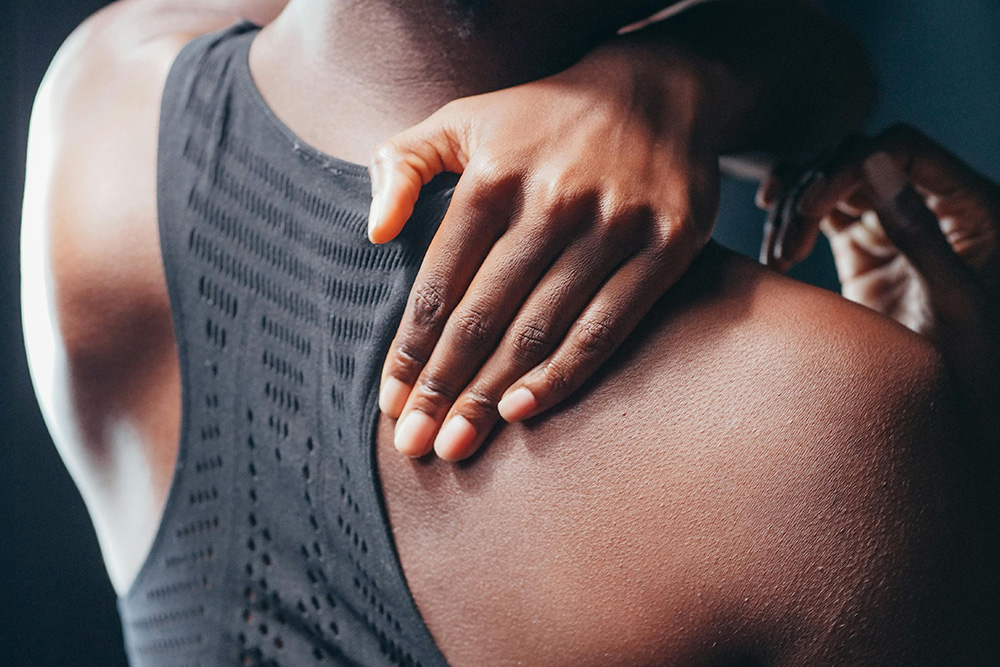
Causes
Stress: Stress can sneak into your shoulders and settle in as tight, achy muscle knots—especially in those deep muscles like the subscapularis and the upper traps. When you’re tense, your body tends to hold that stress in your neck and shoulders, which can lead to stiffness, soreness, and even referred pain down your arm. Over time, those knots can make everyday movements feel more restricted and uncomfortable, especially if you’re not getting enough rest or relaxation.
Head forward posture: Head forward posture—where your head juts out in front of your shoulders—forces the muscles in your upper back and neck to work overtime, fighting gravity to keep your head from drooping. This constant, excessive tension causes those muscles, especially the upper trapezius and levator scapulae, to become chronically tight and fatigued, which is the perfect recipe for developing painful muscle knots. Over time, this posture can lead to muscle imbalance and sustained strain, resulting in chronic neck and shoulder pain that persists.
Rounded shoulders: Rounded shoulders can contribute to shoulder pain by shifting your posture forward, which puts extra strain on your rotator cuff muscles. Over time, this can lead to tightness and muscle knots, especially in areas like the subscapularis and infraspinatus. You might notice your shoulders feeling stiff, achy, or even sore when reaching overhead or sitting for long periods.
Prolonged sitting in a chair hunched over a computer: Sitting with your back rounded forward for extended periods puts significant strain on the muscles in your neck, shoulders, and upper back as they work to support your head. This sustained, awkward posture causes these muscles to become chronically overstretched and fatigued, resulting in tightness, weakness, and a high susceptibility to developing painful muscle knots. Over time, this rounded-back sitting position reinforces a pattern of muscle imbalance and constant tension that contributes to chronic upper-body pain.
Improper Ergonomics: When your desk setup isn’t quite right—like your monitor being too high or your keyboard too far away—it can cause your shoulders to work harder than they need to. That constant strain builds up over time, leading to tight muscles and muscle knots, especially around your neck and upper back. Before you know it, even simple movements can feel stiff or sore, just from sitting the wrong way for too long.
Keeping shoulders elevated for long periods: Prolonged shoulder elevation, such as when typing, driving, or feeling tense, can lead to shoulder pain and muscle knots. It puts constant strain on the muscles around your neck and shoulder blades, particularly the upper traps and rotator cuff, which can become sore and tight. Over time, that tension can build into nagging aches, stiffness, or even sharp pain when you try to move your arms freely.
Working at a high keyboard without proper armrests: This can put extra strain on your shoulders, as they work overtime to keep your arms lifted. That constant tension can lead to tight muscles and painful muscle knots, especially in your neck, shoulders, and upper back. Over time, it can feel like your shoulders are always sore or stiff, even when you’re not doing much.
Poor standing and sitting posture: Poor posture—whether you’re standing or sitting—can quietly lead to shoulder pain and muscle knots over time. When your shoulders round forward or your head juts out, it puts extra strain on the muscles around your neck, upper back, and shoulders. That constant tension can cause those muscles to tighten, leading to soreness, stiffness, and even limited movement.

I Feel
Top of Shoulder Pain
That persistent, aching pain you feel right on top of your shoulder is often caused by tight muscle knots in the thick, superficial muscle, the trapezius (specifically the upper fibers). The discomfort usually concentrates right over the acromioclavicular (AC) joint and can radiate along the side of your neck toward your skull. You’ll notice the pain worsens when you’re doing activities that elevate or tense the shoulders, such as sitting hunched over a keyboard, carrying a heavy bag on one shoulder, or holding a phone between your ear and shoulder. Because the trapezius supports and lifts the shoulder, its knotting can easily mimic deeper issues like AC joint arthritis or rotator cuff tendinopathy. The tissue high on your shoulder is extremely sensitive to pressure, making your shoulder feel stiff and guarded, which prevents you from fully relaxing your arm.
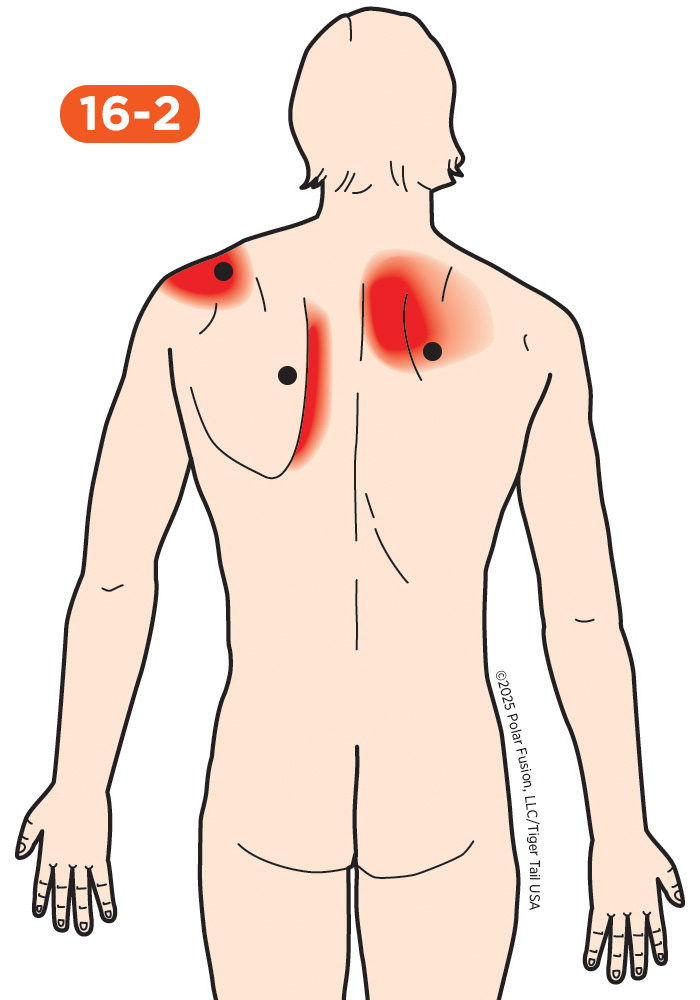
I Feel
Shoulder Stiffness
That nagging shoulder stiffness that makes it hard to turn your head or lift your arms comfortably is often caused by muscle knots in the large, diamond-shaped muscle that spans from your neck across your shoulders and down your upper back, the trapezius. The pain from these muscle knots is often felt as a deep, achy tightness across the top of your shoulders and up into your neck, sometimes creating a heavy, weighted sensation like you’re carrying a burden on your shoulders, which can be mistaken for cervical spine issues, rotator cuff problems, or tension headaches. This type of discomfort is frequently associated with overuse from repetitive activities such as sitting at a computer with poor posture, holding your phone between your shoulder and ear, carrying heavy bags on one shoulder, doing overhead pressing exercises, or maintaining elevated shoulder positions for extended periods. The muscle tissue across the top of your shoulders and upper back will often be extremely tender, feeling tight and knotted, especially at the upper trapezius fibers. Your shoulders may feel restricted and elevated – like they’re constantly pulled up toward your ears — making it difficult to turn your head or reach overhead without discomfort.

I Feel
Back of shoulder pain and stiffness
That persistent pain at the back of your shoulder that feels like a deep knot you can’t reach is often caused by muscle knots in a rope-like muscle running from the top corner of your shoulder blade up to the side of your neck, known as the levator scapulae. The pain from these muscle knots is usually experienced as a deep, nagging ache along the upper inner edge of your shoulder blade and across the back of your shoulder, sometimes producing a burning or stabbing sensation that radiates upward toward your neck or downward along the border of the shoulder blade. It can sometimes be mistaken for a rotator cuff injury, shoulder impingement, or cervical radiculopathy. This type of discomfort is often linked to overuse from repetitive activities such as reaching forward repeatedly (like during computer work), sleeping on your side with your shoulder compressed, carrying heavy bags that pull your shoulder downward and forward, holding your head in a forward position for extended periods, or performing overhead activities. The levator scapulae is often tender and feels like a tight, knotted cord when pressed, and your shoulder blade may feel restricted and stuck—like it can’t glide smoothly over your ribcage. Every time you try to lift your arm or rotate your shoulder, you might notice these restrictions.
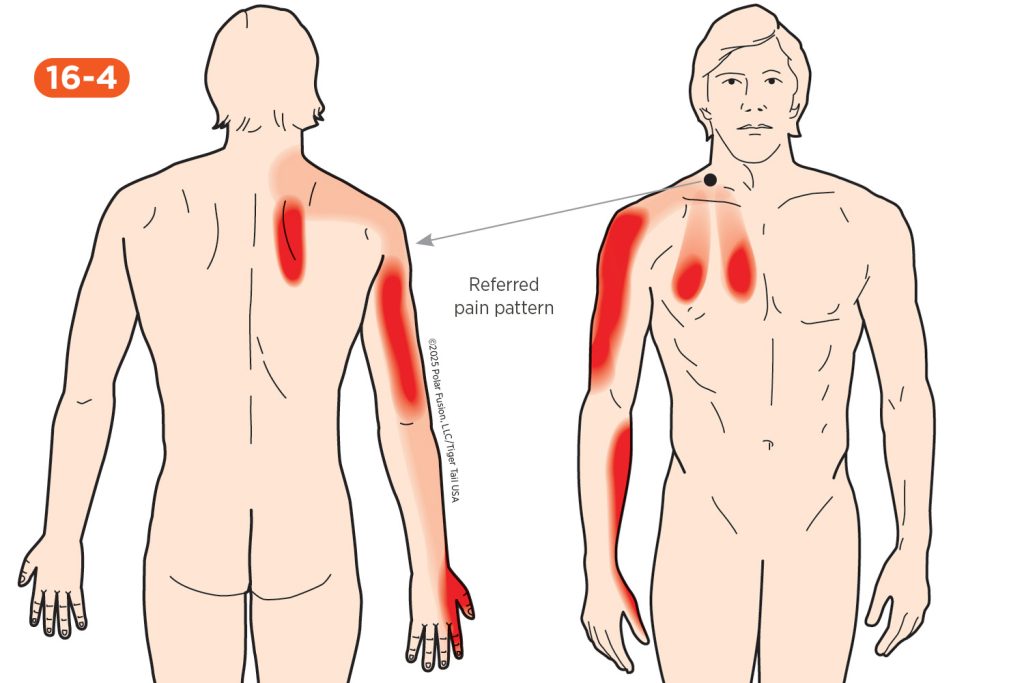
I Feel
Front of Shoulder Pain
That persistent, aching front shoulder pain is often referred pain coming from tight muscle knots in the small, deep neck muscles called the scalenes. The discomfort usually focuses deep in the front of the shoulder near the collarbone, presenting as a deep, taut ache that can extend along the outside of your arm or down the side of your chest. You may find the pain worsens when you do activities that elevate the ribs or stress the neck, such as taking a deep, forceful breath, carrying a heavy bag on one shoulder, or slouching over a computer. Since the scalenes help stabilize the neck and control the first two ribs, their knotting can easily mimic more serious issues like rotator cuff strain or biceps tendinitis. The tissue on the side of the neck can cause your shoulder to feel guarded and restricted, making it hard to lift your arm overhead comfortably.
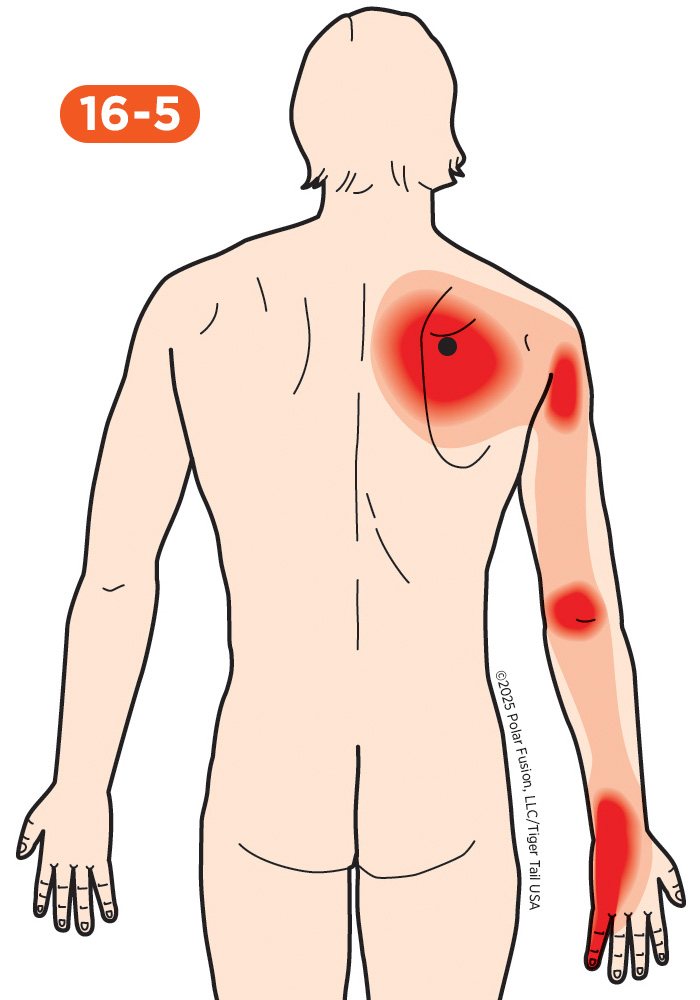
I Feel
Back of Shoulder Pain
That persistent, sharp pain at the back of your shoulder is often referral pain from tight muscle knots in the thin muscle lying deep beneath your upper shoulder blade, the serratus posterior superior. The discomfort usually centers deep beneath the shoulder blade near the spine, appearing as a sharp, pinching ache that can radiate along the back of your shoulder and sometimes into your arm. You may notice the pain worsens during activities that stress the rib cage, such as taking a deep breath, coughing, sneezing, or reaching forward to lift a heavy object. Since this muscle helps elevate the ribs for breathing, its knotting can easily mimic more serious issues like rotator cuff tendinopathy or a rib joint locking. The tissue just under the top part of the shoulder blade is sensitive to pressure, which can leave your shoulder feeling guarded and restricted, making overhead movements difficult.

I Feel
Elbow Pain
Pain in the Back of the Shoulder
The deep, achy pain in the back of your shoulder that won’t go away is often caused by muscle knots in one of the small rotator cuff muscles that sit on top of your shoulder blade, the supraspinatus. The pain from these muscle knots is usually felt as a deep, persistent ache across the back and top of your shoulder and can radiate down the back of your arm. Sometimes, it creates a dull, throbbing sensation that’s hard to pinpoint, which may be mistaken for posterior shoulder impingement, infraspinatus strain, or referred pain from neck issues. This type of discomfort is often linked to overuse from repetitive actions such as reaching forward or across your body repeatedly, holding your arm in static positions (like during computer work), sleeping on the affected shoulder, performing repetitive lifting or carrying, or engaging in activities that require sustained shoulder stability, like holding a steering wheel for long stretches. The muscle on top of your shoulder blade is typically very tender and feels tight or dense when pressed. Your shoulder might also feel weak and tired. It’s like there’s a constant deep ache in the back that makes it uncomfortable to rest your arm in any position, and you’ve lost the solid, stable feeling in your shoulder joint.
Discomfort with Overhead Movement
Suppose you’re experiencing sharp discomfort with overhead movement. In that case, the problem is often tightness and muscle knots in a small rotator cuff muscle that sits on top of the shoulder blade, the supraspinatus. The discomfort typically focuses on the top and front of the shoulder, presenting as a sharp, pinching pain when you lift your arm to the side. You may notice that the pain worsens during activities involving lifting, such as throwing a ball, washing your hair, or reaching to open a high cupboard. Because the supraspinatus operates in a tight space, its knotting can easily mimic deeper issues like shoulder impingement syndrome or bursitis. The supraspinatus can cause your shoulder to feel restricted and unstable, making sustained overhead work impossible.
Deep Shoulder Joint Pain
That deep shoulder joint pain that’s hard to locate is often caused by tight muscle knots in the muscle on top of the shoulder blade, the supraspinatus, which can send pain directly into the core of the joint. The discomfort usually concentrates deep inside the shoulder socket, presenting as a constant, heavy ache that can get worse at night and radiates down the outside of the arm. You’ll notice the pain significantly increases when you’re doing activities that load the shoulder, such as carrying a child, pushing a heavy door, or lifting weights. Since the supraspinatus helps stabilize the humerus within the joint, its knotting can closely resemble more serious issues like a labral tear or frozen shoulder. The muscle high on top of the shoulder blade is vulnerable to pressure, causing your entire shoulder to feel guarded and restricted, limiting almost all movements. Interestingly, it’s notorious for being the classic shoulder pain that wakes you up at night when you try to sleep on the affected side.
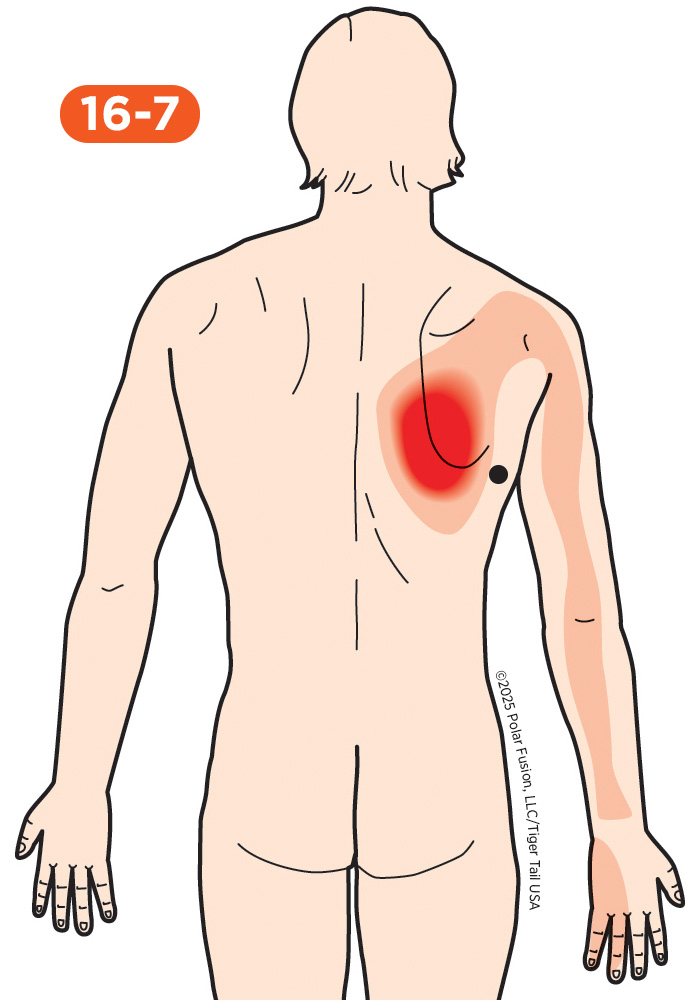
I Feel
Pseudothoracic Outlet Syndrome
That confusing feeling of numbness or tingling down your arm and hand can sometimes be referred pain originating from tight muscle knots in the large “wing” muscle, the latissimus dorsi. The discomfort typically concentrates across the middle-to-lower rib cage and can radiate along the side of your torso and down the arm. The tingling and pain often worsen significantly during activities that involve reaching or pulling, like opening a heavy door, carrying a heavy suitcase, or sleeping with your arm overhead. Since the latissimus dorsi connects the arm to the spine and ribs, its knotting can easily mimic deeper issues like thoracic outlet syndrome (actual nerve or vessel compression) or a cervical nerve pinch. The tissue on the side of your back, near the lower ribs, is highly sensitive to pressure, which can cause your torso to feel stiff and restricted, limiting your ability to lift your arm fully.

I Feel
Pain Between the Shoulder Blades
That persistent, aching pain right between your shoulder blades is the classic symptom caused by chronic muscle knots in the Rhomboids (Rhomboideus major and minor). The discomfort usually focuses directly on the edge of the spine under the shoulder blade, presenting as a deep, dull ache that feels like a persistent strain or tension. You’ll find the pain gets significantly worse when you’re doing activities that round the shoulders forward, like sitting hunched over a desk, driving for long periods, or reaching forward to lift something. Because the Rhomboids pull the shoulder blades together, their knotting can easily mimic deeper problems like rib joint dysfunction or cervical nerve irritation. The tissue right between the shoulder blades is extremely sensitive to pressure, and it leaves your back feeling stiff and restricted, preventing your shoulders from pulling back naturally.
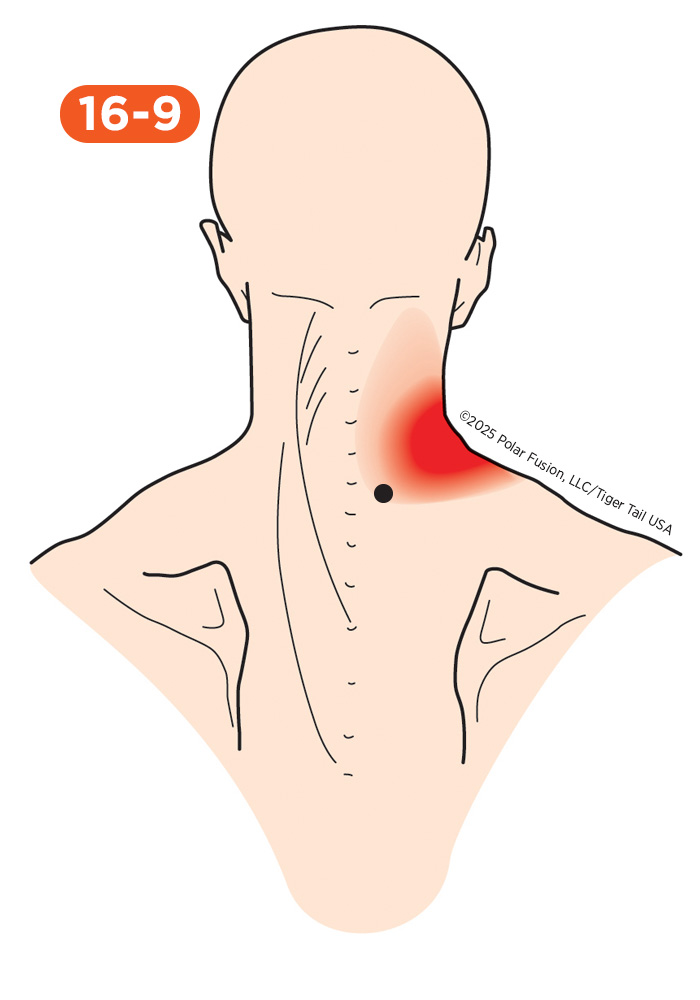
I Feel
Upper Shoulder Pain
That persistent, achy pain you feel on the side of your upper shoulder is often referred pain from tight muscle knots in the deep neck muscle, the splenius cervicis. The discomfort typically focuses right where the neck meets the outer shoulder, presenting as a deep, nagging ache that can sometimes run along the outside of your collarbone. You’ll find the pain worsens when you’re doing activities that hold your head in a fixed, rotated position, like turning your head sharply while driving, sleeping on a high pillow, or looking down and to the side for a long time. Since the splenius cervicis muscle moves the head and neck, it can easily mimic deeper problems, such as AC joint arthritis or rotator cuff strain. The muscle high on the side of the lower neck is very sensitive to pressure and can leave your shoulder feeling guarded and restricted, making lateral arm lifting difficult.
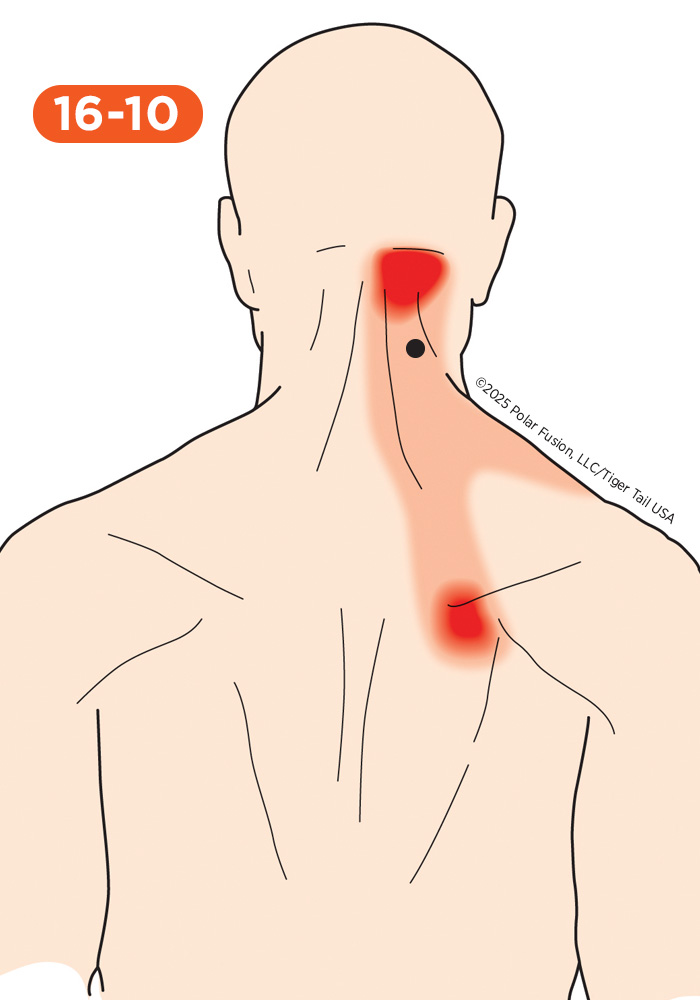
I Feel
Back of Shoulder Pain
That deep, centered back shoulder pain you feel could be referred pain from chronic muscle knots in the small, deep stabilizing muscles of your neck, called the cervical multifidi. The discomfort usually centers deep in the shoulder socket or just below the neck on the spine, appearing as a deep, constant throbbing that feels like a persistent pinch. You’ll notice the pain worsens when you perform movements that require keeping your head steady, such as looking down at a phone, driving for long periods without neck support, or carrying a heavy bag on one shoulder. Since these muscles help fine-tune neck stability, their muscle knots can easily mimic more serious issues like rotator cuff tendinopathy or cervical facet joint dysfunction. The muscles near the neck can also cause your neck and shoulder to feel stiff and restricted, severely limiting your arm and head movements.
Rotator Cuff
Causes
Age: As we age, the tissues in our shoulders—like tendons and muscles—can lose elasticity and strength, making them more prone to strain and injury. This can lead to discomfort and tightness, especially if posture or movement patterns change over time. Muscle knots often form as the body tries to protect or compensate for these changes, creating areas of tension that can be quite painful.

I Feel
Pain in the Back of the Shoulder
That persistent, dull pain at the back of your shoulder is often caused by tight muscle knots in the small stabilizing muscle called the teres minor. The discomfort usually concentrates right at the rear edge of the shoulder blade near the joint, presenting as a deep, dull ache that can radiate along the back of the shoulder. You may notice the pain intensifies when you’re doing internal rotation and reaching—like tucking in your shirt, fastening your bra behind your back, reaching across your body, or sleeping on the affected side. Because the teres minor externally rotates the arm, its knotting can easily mimic more serious issues like a rotator cuff tear or posterior labral strain. When you press into the muscle deep in the back of your shoulder (along the outer edge of your shoulder blade), you’ll likely find it’s highly tender, and your shoulder may feel guarded and restricted—like you can’t comfortably rotate your arm inward or reach across your body without that deep ache worsening.

I Feel
Pain When Sleeping on Either Side
If you wake up with sharp pain when sleeping on either side, the cause is often chronic muscle knots in the muscle behind the shoulder blade, the infraspinatus. The discomfort typically focuses deep inside the shoulder joint, presenting as a deep, throbbing ache that makes it hard to find a comfortable position. The pain tends to worsen during activities that compress the joint, such as lying directly on the affected shoulder, reaching across your body, or holding your arm out in front (like driving). Since the infraspinatus is the primary external rotator, its knotting can easily mimic more serious issues, such as shoulder joint arthritis or bursitis. Pressing on the muscle beneath the back of your shoulder blade will likely cause it to feel painfully sore and reactive, often with tight knots scattered throughout. Your entire shoulder may feel unstable and restricted, making it hard to find a comfortable position at night, leading you to constantly shift to avoid that deep, throbbing pain.
Discomfort With Overhead Movement
If you’re dealing with sharp discomfort during overhead movement, the problem is often tightness and muscle knots in the large rotator cuff muscle, the infraspinatus. The pain typically focuses deep in the joint and radiates to the front of the shoulder, presenting as a sharp, pinching sensation during arm movements such as lifting and lowering. You’ll notice the pain worsens significantly with activities involving lifting, such as throwing a ball, washing windows, or reaching for a high shelf. Since the infraspinatus helps stabilize the shoulder joint, its knotting can mimic deeper issues like shoulder impingement syndrome or biceps tendinitis. Pressing on the muscle high on the back of your shoulder blade usually reveals notable tenderness and dense trigger points, and your shoulder may feel restricted and unstable — as if you’ve lost the strength and control to lift your arm overhead safely without that sharp, catching pain. .
Pain at the Front of the Shoulder
That mysterious, achy pain at the front of the shoulder is often referred pain coming from tight muscle knots in the large rotator cuff muscle, the infraspinatus. The discomfort usually focuses deep in the joint near the bicep tendon, presenting as a deep, dull ache that can make your arm feel heavy and fatigued. You’ll find the pain gets significantly worse when you’re doing internal rotation and pressing movements, like pushing a heavy door, reaching behind your back, or driving for extended periods. Because the infraspinatus influences the ball-and-socket position, its knotting can easily mimic deeper problems like biceps tendinitis or AC joint irritation. Applying pressure to the muscle high on the back of your shoulder blade, it typically responds with intense tenderness even though your pain is in the front, and your shoulder will feel guarded and restricted—like you can’t comfortably lift or rotate your arm without that deep frontal ache that seems to come from inside the joint.
Deep Shoulder Joint Pain
That deep, internal, and widespread shoulder joint pain is often caused by tight muscle knots in the main external rotator, the infraspinatus. The discomfort usually resides deep inside the shoulder socket, presenting as a constant, heavy ache that can intensify at night and radiate along the outside of the arm. The pain significantly worsens during activities that require sustained joint stability, such as carrying heavy objects, pushing a wheelchair, or lifting weights. Since the infraspinatus stabilizes the humerus within the joint, its knotting can easily mimic more serious issues like a labral tear or frozen shoulder. Applying direct pressure high on the back of your shoulder blade typically reveals marked sensitivity throughout the entire muscle, and your whole shoulder may feel guarded and limited — almost all movements feel restricted and painful because the joint doesn’t feel stable or secure anymore.

I Feel
Pseudothoracic Outlet Syndrome
That confusing feeling of numbness or tingling down your arm and hand can sometimes be referred pain coming from tight muscle knots in the thick, deep shoulder muscle, the teres major. The discomfort usually focuses deep in the back of the armpit and shoulder blade, presenting as a deep, heavy ache that can run along the back of the arm down to the elbow. You’ll find the tingling and pain get significantly worse when you’re doing activities that compress the shoulder area, like carrying a heavy backpack strap, sleeping with your arm pulled across your chest, or driving for extended periods. Because the teres major lies close to the nerves and vessels leaving the neck, its knotting can easily mimic deeper problems like thoracic outlet syndrome (actual nerve/vessel compression) or a cervical nerve pinch. Touching the muscle along the outer edge of your shoulder blade (in your armpit area, running from the lower scapula to your arm) frequently produces significant soreness. Your shoulder and arm will feel restricted and heavy, as if circulation is compromised or nerves are interfering, making your arm feel weak, tingly, and fatigued even though the problem is muscular.
Pain Reaching Up And Forward
If you’re experiencing sharp pain when reaching up and forward (like lifting a box), the issue is often tightness and muscle knots in the powerful teres major muscle. The discomfort usually focuses deep in the back of the armpit, presenting as a sharp, intense pulling pain when the muscle stretches. You’ll notice the pain worsens significantly during forceful movements, such as reaching for the back seat of your car, serving a tennis ball, or carrying a heavy object away from your body. Since the teres major pulls the arm toward the body, its knotting can easily mimic more serious problems like a latissimus dorsi strain or shoulder impingement syndrome. The tissue deep in the back of the armpit is sensitive to pressure, causing your shoulder to feel guarded and restricted, which makes full reach and shoulder flexion painful.
Top of Shoulder Pain
When that sturdy muscle on the lower part of your shoulder blade, the teres major, decides to cause you grief, the pain tends to be specific and intense. You’ll usually feel a strong, deep ache right along the top of your arm and shoulder, sometimes wrapping around to the shoulder blade area. This muscle’s job is to help pull your arm down and toward your body (think of doing a pull-up), so activities that require strength in that movement—such as rowing, lifting heavy objects, or forcefully pulling something toward you—can cause the pain to intensify. The discomfort often resembles a strained muscle and can be quite tender if you press on the area just below your armpit. When this muscle is tight, it limits your ability to fully reach overhead, making your arm feel heavy and resistant to movement.

I Feel
Pseudothoracic Outlet Syndrome
That confusing feeling of numbness or tingling down your arm and hand can sometimes be referred pain coming from tight muscle knots in the thick, deep shoulder muscle, the teres major. The discomfort usually focuses deep in the back of the armpit and shoulder blade, presenting as a deep, heavy ache that can run along the back of the arm down to the elbow. You’ll find the tingling and pain get significantly worse when you’re doing activities that compress the shoulder area, like carrying a heavy backpack strap, sleeping with your arm pulled across your chest, or driving for extended periods. Because the teres major lies close to the nerves and vessels leaving the neck, its knotting can easily mimic deeper problems like thoracic outlet syndrome (actual nerve/vessel compression) or a cervical nerve pinch. Touching the muscle along the outer edge of your shoulder blade (in your armpit area, running from the lower scapula to your arm) frequently produces significant soreness. Your shoulder and arm will feel restricted and heavy, as if circulation is compromised or nerves are interfering, making your arm feel weak, tingly, and fatigued even though the problem is muscular.
Pain Reaching Up And Forward
If you’re experiencing sharp pain when reaching up and forward (like lifting a box), the issue is often tightness and muscle knots in the powerful teres major muscle. The discomfort usually focuses deep in the back of the armpit, presenting as a sharp, intense pulling pain when the muscle stretches. You’ll notice the pain worsens significantly during forceful movements, such as reaching for the back seat of your car, serving a tennis ball, or carrying a heavy object away from your body. Since the teres major pulls the arm toward the body, its knotting can easily mimic more serious problems like a latissimus dorsi strain or shoulder impingement syndrome. The tissue deep in the back of the armpit is sensitive to pressure, causing your shoulder to feel guarded and restricted, which makes full reach and shoulder flexion painful.

I Feel
Front of Shoulder Pain
That persistent, aching front shoulder pain is often caused by deep muscle knots in the small muscle near your armpit, the coracobrachialis. The discomfort typically focuses deep in the front of the joint near the bicep groove, presenting as a deep, constant ache that can radiate along the inside of your upper arm. You may notice that the pain worsens during activities that shorten the muscle, such as holding a phone to your ear, reaching across your body, or sitting with your elbows forward. Since the coracobrachialis helps with arm flexion, its knotting can mimic more serious issues, like biceps tendinitis or AC joint irritation. The muscle tissue is often tender and reactive to touch, leaving your shoulder feeling guarded and restricted, especially when trying to lift your arm out to the side.
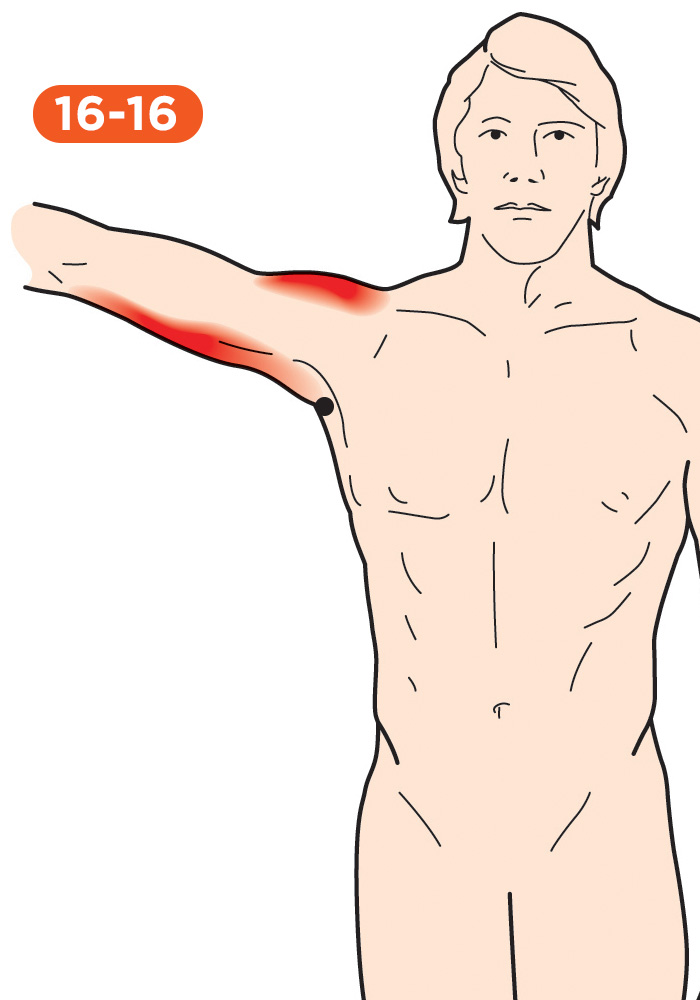
I Feel
Pain in the Back of the Shoulder
That confusing pain at the back of your shoulder is often caused by tight muscle knots in the largest rotator cuff muscle, the subscapularis. The pain from these trigger points usually feels like a deep, aching pain across the back of your shoulder and along your arm, sometimes wrapping around toward your wrist as a band of discomfort. This can be mistaken for infraspinatus strain, posterior impingement, or referred pain from thoracic spine issues. You’ll likely notice the pain worsens when you reach behind your back (such as fastening a bra or reaching for your wallet), perform external rotation movements, keep your arm in static positions, carry bags with your arm at your side, or sleep on the affected shoulder. Pressing on the muscle will probably be very sore and feel like tight bands throughout, and your shoulder may feel restricted and guarded – as if you’ve lost range of motion in multiple directions, with that deep, posterior ache limiting almost everything you try to do.
Pain When Sleeping on Either Side
If you wake up with intense pain when sleeping on either side, the cause is often chronic muscle knots in the muscle in front of the shoulder blade, called the subscapularis muscle. The discomfort usually focuses deep inside the shoulder socket, presenting as a deep, throbbing ache that makes it impossible to find a comfortable position. The pain tends to worsen significantly during activities that compress the shoulder, like lying directly on the affected side, carrying a heavy bag across your chest, or reaching overhead for extended periods. Since the subscapularis helps stabilize the shoulder, its knotting can mimic more serious issues, such as shoulder joint arthritis or bursitis. The muscle tissue deep on the front of the shoulder is vulnerable to pressure, leading your entire shoulder to feel unstable and restricted, which can cause you to wake up frequently at night.
Discomfort With Overhead Movement
Sharp discomfort and restriction every time you try to lift your arm overhead are often caused by muscle knots in the underside of your shoulder blade, the subscapularis. The pain from these muscle knots is usually felt as a sharp, catching sensation deep in the shoulder joint that can radiate down the back of your arm during overhead movements, sometimes accompanied by a clicking or popping sound, which can be mistaken for shoulder impingement, rotator cuff tears, or labral pathology. You’ll really notice the pain worsening when reaching overhead to grab something, performing overhead pressing exercises, throwing, swimming, painting ceilings or walls, or any activity that requires sustained arm elevation combined with rotation. The subscapularis can respond with intense tenderness and tight, ropy bands, and your shoulder may feel locked and restricted—like you physically can’t get your arm fully overhead without that sharp, stopping pain that makes you immediately want to lower your arm.
Frozen Shoulder
If your shoulder feels like it’s “freezing up” or losing range of motion, the cause is often chronic, severe muscle knots in the muscle at the front of the shoulder blade, called the subscapularis. This discomfort usually centers deep inside the shoulder joint, presenting as a constant, heavy ache that limits nearly all movement. The restriction tends to worsen during any activity that stretches the front of the joint, such as reaching behind your back, putting on a seatbelt, or lifting your arm away from your side. Because the subscapularis pulls the arm inward, chronic knotting in this muscle can easily mimic deeper issues like adhesive capsulitis (true frozen shoulder) or severe capsular tightness. The muscle deep on the front of the shoulder is highly sensitive to pressure, causing your arm to feel completely guarded and restricted, which makes even simple tasks like dressing painful.
Pseudothoracic Outlet Syndrome
That confusing feeling of numbness or tingling running down your arm and into your hand, which makes you worry about nerve or circulation problems, is often caused by muscle knots in the muscle that sits on the underside of your shoulder blade, the subscapularis. The pain from these muscle knots is often felt as a deep, heavy ache in your armpit and the front of your shoulder, extending along the inside of your upper arm down to your elbow. Sometimes, it’s accompanied by tingling, numbness, or a feeling of heaviness in your hand, which can be mistaken for true thoracic outlet syndrome (actual nerve or vessel compression), cervical nerve pinch, or ulnar nerve entrapment. You’ll notice the tingling and pain worsen when you carry a heavy bag across your chest, drive for long periods with your hands on the wheel, sleep with your arm pulled across your body, do repetitive reaching forward movements, or hold your arm in static positions that compress the shoulder area. Touching the subscapularis often causes significant soreness, and your arm may feel heavy and restricted—as if circulation or nerves are compromised—making it feel weak, tingly, and numb, even though the actual source is muscle knots.
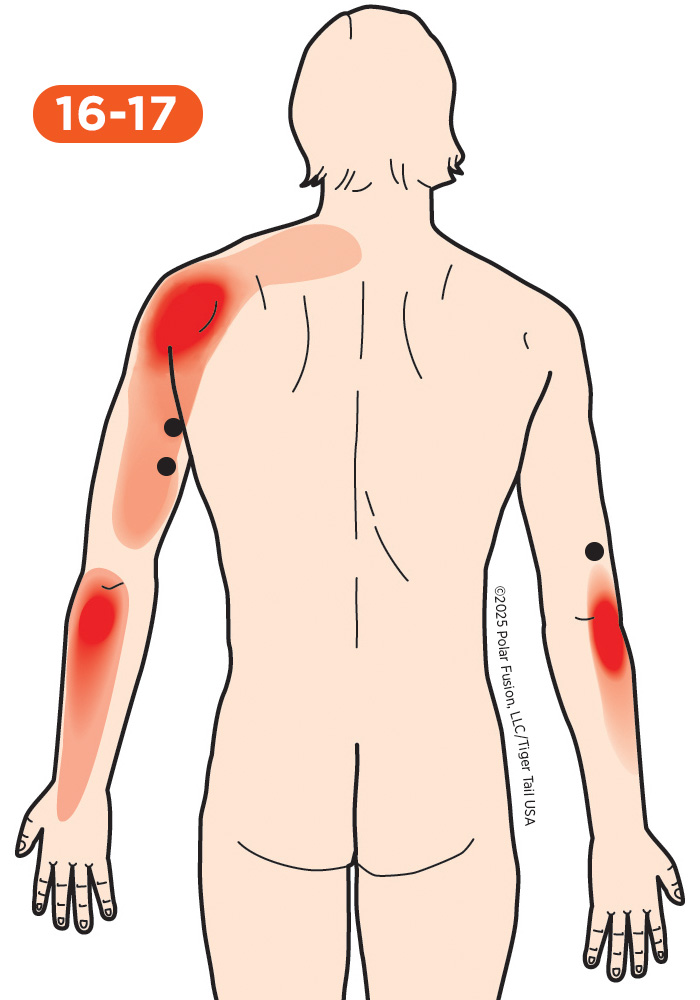
I Feel
Elbow Pain
That sharp, nagging pain you feel at the back of your elbow is often caused by tight muscle knots in the large muscle on the back of your arm, the triceps. The discomfort usually focuses right over the bony point of the elbow and can radiate along the back of your upper arm toward the shoulder. You’ll find the pain worsens during activities that require elbow extension or heavy pressing, like push-ups, pushing a heavy door, or lifting something overhead. Since the triceps connects directly to the elbow bone, its knots can easily mimic deeper problems such as olecranon bursitis or ulnar nerve irritation. The muscle belly on the back of the upper arm is often tender to pressure, and it can make your elbow feel guarded and restricted, making it difficult to fully straighten your arm.
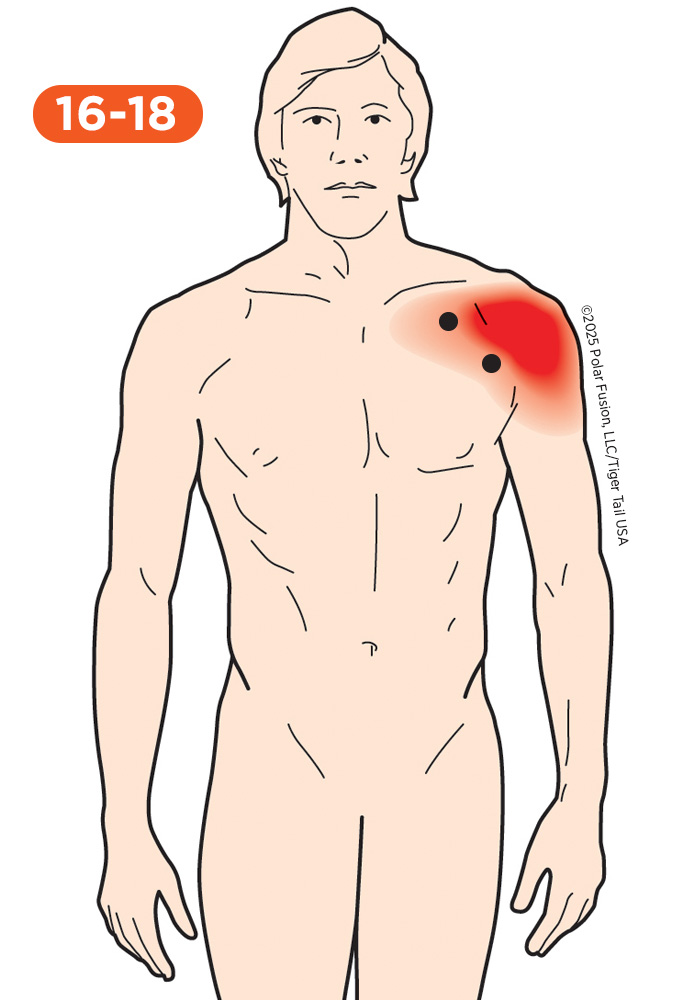
I Feel
Front of Shoulder Pain
When the upper part of your chest muscle, the pectoralis major clavicular section, is the source of discomfort, the pain is localized to the front of your shoulder, presenting as a deep, ache where the shoulder meets the chest, often running along the collarbone. You’ll notice the pain gets significantly worse when you’re doing chest exercises, pushing a heavy object, or even just reaching across your body. It can be extremely sensitive to pressure near the shoulder joint, and issues here can sometimes mimic deeper shoulder problems, leaving the joint feeling tight and restricted, especially when trying to pull the shoulder blades back.
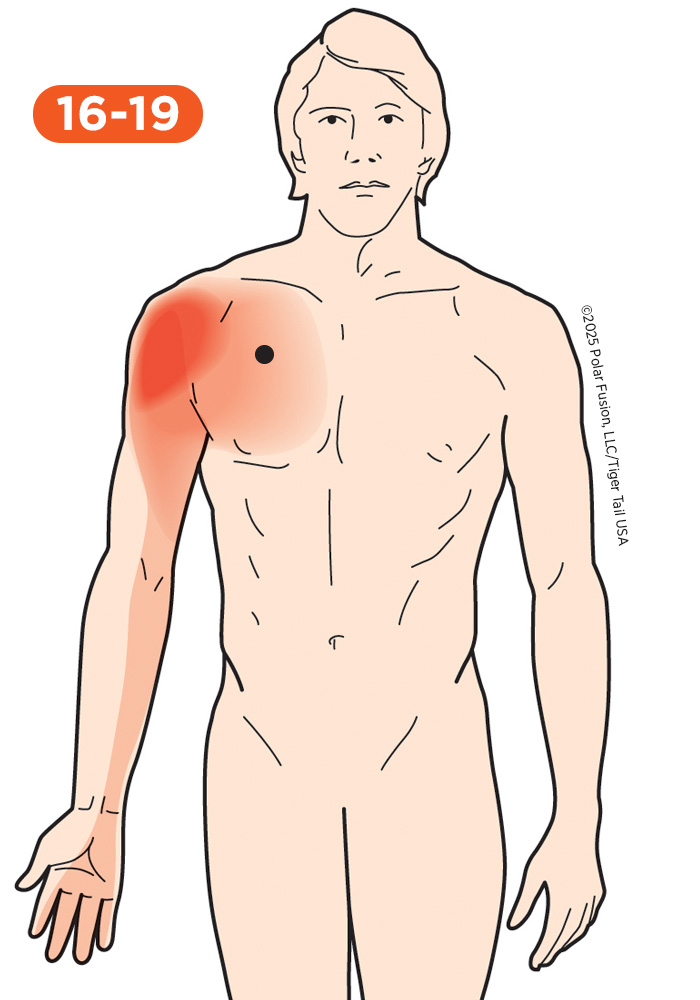
I Feel
Shoulder, Chest, Arm, and Finger Pain
That confusing pain that hits your shoulder, chest, arm, and even your fingers is often caused by tight muscle knots in the smaller chest muscle, the pectoralis minor. The discomfort usually focuses under the collarbone and into the armpit, presenting as a sharp, burning tingle that dramatically runs along the inner arm and hand. You’ll find the tingling and pain get significantly worse when you’re doing activities that round the shoulders, like slouching while driving, carrying a heavy bag across your chest, or sleeping on your side with your arm forward. Because the pectoralis minor can pinch nerves and vessels (like in thoracic outlet syndrome), its knotting can easily mimic deeper problems like a cervical disc herniation or true thoracic outlet syndrome. The tissue under the collarbone is sensitive to pressure, and it leaves your shoulder feeling guarded and restricted, especially when trying to pull your shoulders back.
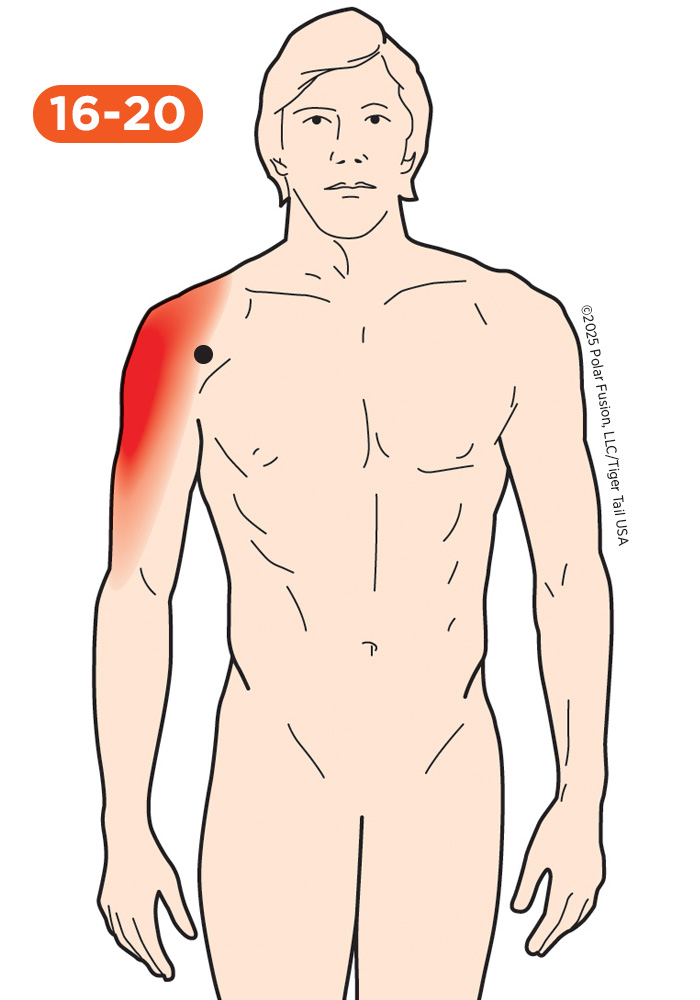
I Feel
Front of Shoulder Joint Pain
That sharp, achy pain right in the front of your shoulder, which worsens with lifting, is often caused by muscle knots in the front shoulder muscle, the anterior deltoid. The pain from these muscle knots usually feels like a deep, burning ache across the front of your shoulder that can radiate down the front of your upper arm. Sometimes, it creates a sensation of weakness when trying to lift objects, which can be mistaken for rotator cuff tears, biceps tendinitis, or anterior shoulder impingement. You’ll really notice the pain worsening when you’re reaching forward or overhead, doing pushing exercises like push-ups or bench presses, lifting objects in front of you, carrying bags or groceries, or holding your arms out in front (like when driving or typing for extended periods). When you press into the muscle on the front of your shoulder—the rounded cap over the front of your joint—you’ll likely find it is exceptionally tender, with tight bands running through it. Your shoulder may also feel fatigued and weak, as if you’ve lost strength in forward lifting movements, and the burning ache can make it difficult to use your arm comfortably in front of your body.

I Feel
Back of Shoulder Pain
That persistent, dull pain at the back of your shoulder that won’t go away is often caused by muscle knots in the rear part of your shoulder cap, the posterior deltoid muscle. The pain from these knots usually feels like a deep, dull ache across the back of your shoulder, which can radiate down the back of your upper arm toward the elbow. Sometimes, it creates a constant background discomfort that worsens with specific movements and can be mistaken for rotator cuff strain, posterior impingement, or referred pain from the neck. You’ll really notice the pain worsening when performing pulling exercises, such as rows, reaching behind your back, sleeping on the affected shoulder, or doing overhead movements that require shoulder stability. Additionally, holding your arm in static positions that engage the back of your shoulder can make the pain worse. If you press on the muscle at the back of your shoulder (the rounded cap over the rear of your joint), your shoulder will feel tight and restricted – like you can’t comfortably reach behind you or pull objects toward your body without that deep, nagging ache limiting your strength and range of motion.
Discomfort With Overhead Movement
If you’re dealing with sharp discomfort with overhead movement, the issue is often tightness and muscle knots in the back part of your shoulder cap, the posterior deltoid. The discomfort usually focuses deep in the joint and the back of the shoulder, presenting as a sharp, pinching pain when you lift your arm high. You’ll find the pain gets significantly worse when you’re doing activities that require a full range of motion, like throwing a ball, washing your hair, or reaching for a high shelf. Because the posterior deltoid helps stabilize the shoulder when lifting, its knotting can easily mimic deeper problems, such as shoulder impingement syndrome or a rotator cuff tear. The tissue on the back of the shoulder is extremely sensitive to pressure, leaving your shoulder feeling guarded and restricted, which makes sustained overhead work painful.
